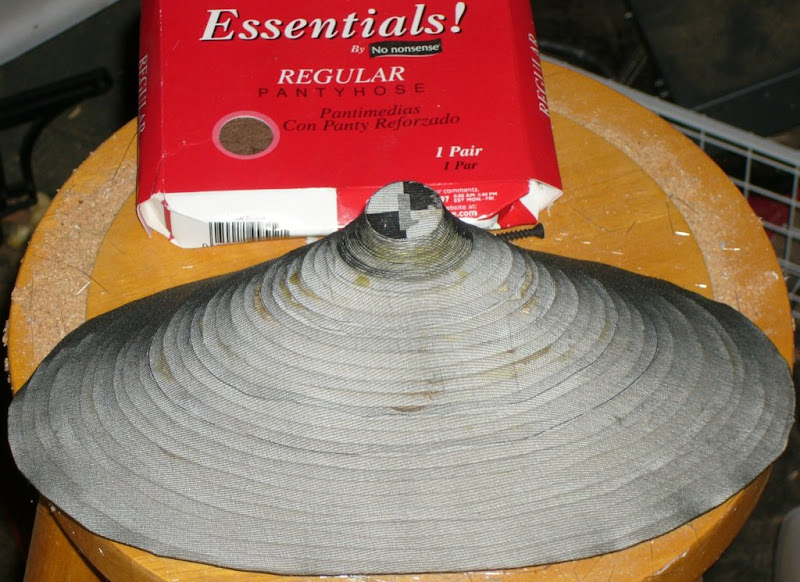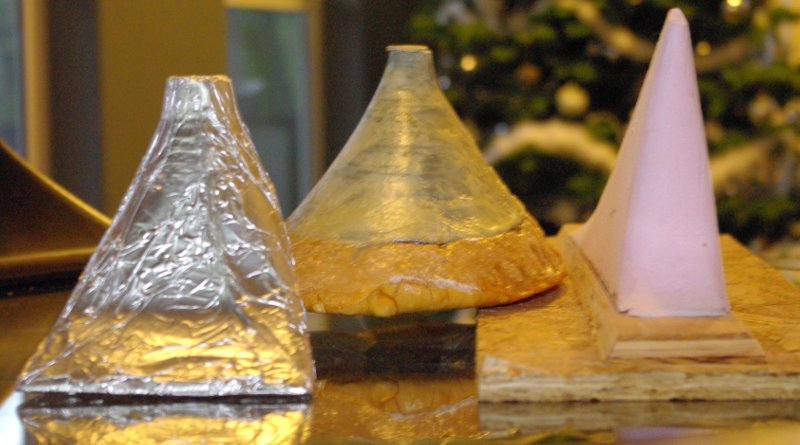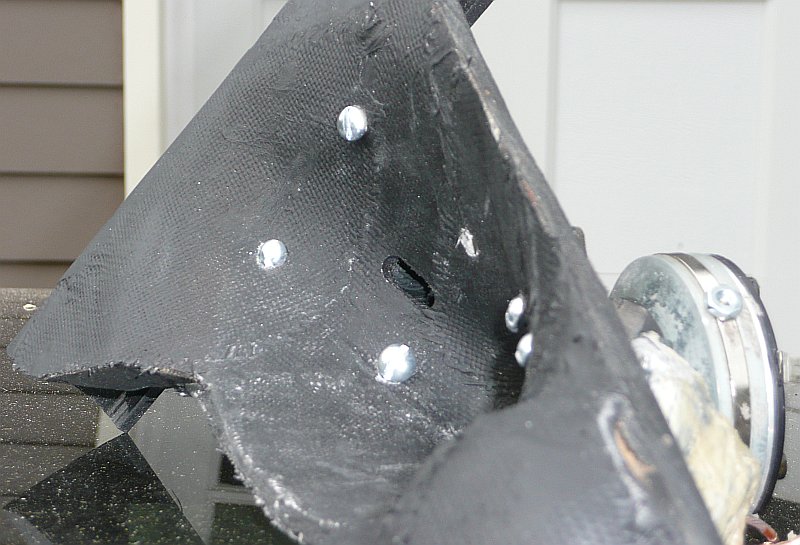I've seen Earl's speakers up close a time or two, and have a 12" Parts Express waveguide in my garage, which I have measured with several different compression drivers. I don't see how the PE waveguide could be modified to closely approximate one of Earl's. The throat is different. The profile is different. The mouth is different.
I've seen Earl's speakers up close a time or two, and have a 12" Parts Express waveguide in my garage, which I have measured with several different compression drivers. I don't see how the PE waveguide could be modified to closely approximate one of Earl's. The throat is different. The profile is different. The mouth is different.
All true. All changed (or in the process of changing). In fact, the only portion of the guide that will be still original will be a single ring about halfway down the axial length of the guide, where the original curvature is equal to the overlaid OS profile. The rest has been built up and filled up and smoothed. The PE waveguide has a too large throat- I made an insert and molded in a new throat, with a transition into a conical profile. Following this step I traced the modified curvature, and it was much like a Tractrix mouth expansion tacked onto an OS throat and and initial conical expansion. Being unhappy with how this would deviate from CD, I have undertaken it to extend the conical section through and beyond the face of the stock waveguide.
Essentially, it's just a threaded mount and framework onto which the profile is being laid. It's a beast. Thus far I've used silicate filler and epoxy and wood and formed foam and am about to apply the plaster cloth) and another trick or three. Scrounging up the money for the good doctor would have been easier, but I am managing to learn how to make some pretty precise waveguides. Perhaps I'll win the race to an ellipsoidal OS
Last edited:
Essentially, it's just a threaded mount and framework onto which the profile is being laid. It's a beast. Thus far I've used silicate filler and epoxy and wood and formed foam and am about to apply the plaster cloth) and another trick or three. Scrounging up the money for the good doctor would have been easier, but I am managing to learn how to make some pretty precise waveguides. Perhaps I'll win the race to an ellipsoidal OS
I published instructions on how to make an elliptical oblate spheroidal waveguide back in 2006. It's on this forum, along with plans. I think I x-posted it to htguide also.

The waveguide shape is built up using cardboard, popsicle sticks to seperate the layers, and panty hose to smooth out the shape. Epoxy or fiberglass is used to build up the strength.

A family portrait. In the middle is my old OS mold from '06, along with a couple other curves that didn't work out as well. The OS works very nice.

From the side, you can see the curve fairly well. These are in my car.
I'm kind of surprised more people don't make their own molds. It's fun. Cutting the foam plug is a p.i.t.a., but mold making is kind of hypnotic.
Patrick, I didn't ever see a proper mouth termination of your OS profile? Did you manage to roll back the lip, that seems the trickiest part of it, apart from the throat. I have a method for doing the rest of the profile but that lip has eluded me. I'm working hard to achieve a very smooth surface, not that it's AS crucial once the foam's in place (beyond the throat anyway)
I've had to use a variety of filler materials for the task, requiring different characteristics. The bottom filler is a dimensionally stable epoxy, made for body filler work without fiberglass reinforcement. This let me fill gaps between the wood section of the frame and the PE guide without worrying about sagging. A silicate filler was used for the throat, overlaid with 'wet' epoxy. The silicate can be formed but is weak, the wet epoxy seals and stabilizes it. The current coat is Bondo wood filler, basically sawdust mixed with 30 minute epoxy. This is good for much of the filling so long as it needn't be more than about 1/2 thick. It does heat up while curing, I have it outside in the morning air with a fan blowing on it while it does so.
I wish earl were still selling the 15" waveguides, but since he's not, I'm between a rock and a hard place. I don't have summa money but want to try the concept.
I've had to use a variety of filler materials for the task, requiring different characteristics. The bottom filler is a dimensionally stable epoxy, made for body filler work without fiberglass reinforcement. This let me fill gaps between the wood section of the frame and the PE guide without worrying about sagging. A silicate filler was used for the throat, overlaid with 'wet' epoxy. The silicate can be formed but is weak, the wet epoxy seals and stabilizes it. The current coat is Bondo wood filler, basically sawdust mixed with 30 minute epoxy. This is good for much of the filling so long as it needn't be more than about 1/2 thick. It does heat up while curing, I have it outside in the morning air with a fan blowing on it while it does so.
I wish earl were still selling the 15" waveguides, but since he's not, I'm between a rock and a hard place. I don't have summa money but want to try the concept.
I wish earl were still selling the 15" waveguides, but since he's not, I'm between a rock and a hard place. I don't have summa money but want to try the concept.
Its not that I won't sell them, its just that I found that the prices were not such that I was making any money, and people kept complaining about them so I just stopped. I can have 15" made, but by someone else, and that just adds cost. Basically, PM me if you seriously want a pair of 15"s, but remember that the prices have to be higher than what they were or its not worth it to me.
Patrick, I didn't ever see a proper mouth termination of your OS profile? Did you manage to roll back the lip, that seems the trickiest part of it, apart from the throat. I have a method for doing the rest of the profile but that lip has eluded me. I'm working hard to achieve a very smooth surface, not that it's AS crucial once the foam's in place (beyond the throat anyway)
I've actually found that getting the mouth right is more difficult than the throat. A bit of bondo and a round file will get you a long way at the throat.
My elliptical waveguide is basically the same angle as the windshield in my car (I measured it), so the roundover is less of an issue. The important thing is to maintain a smooth transition from waveguide to windshield. It's difficult to see in the pics, because the windshield is transparent, but that transition from waveguide to windshield is very carefully optimized.
Same thing applies in a room - so you're mouth termination will depend on whether they're radiating into free space, or soffit mounted. This afternoon I will be publishing some information on how to do the latter.
Its not that I won't sell them, its just that I found that the prices were not such that I was making any money, and people kept complaining about them so I just stopped. I can have 15" made, but by someone else, and that just adds cost. Basically, PM me if you seriously want a pair of 15"s, but remember that the prices have to be higher than what they were or its not worth it to me.
Too late now! I'm a lot of hours and material into this project, and have some seemingly very close approximations of your waveguides nearly made up, 16" wide. The flare itself is only about 14.5" at the launch plane (what would be the baffle plane in a summa) I'm assuming the 15" was chosen as to provide full polar control at 1k?
I'll reiterate that these have been hell to build.
Too late now! I'm a lot of hours and material into this project, and have some seemingly very close approximations of your waveguides nearly made up, 16" wide. The flare itself is only about 14.5" at the launch plane (what would be the baffle plane in a summa) I'm assuming the 15" was chosen as to provide full polar control at 1k?
I'll reiterate that these have been hell to build.
The Summa waveguide is 15" unflared in the baffle plain and about 18" in the flared case. This gives decent control down to about 1 kHz, but there is still a little narrowing at the lowest frequencies.
Ideally I would like to see a system that has narrow directivity down to 500Hz (and lower). Practical?
Not in anything of reasonable size. Basically each octave lower doubles the radius requirement, which means 4 times the area. The waveguide gets big very fast.
Merry Christmas to all as well.
So for 500Hz we would end up with 22.5" unflared? That's big but is it also impractical? How would the specifications for a matching mid-woofer look like?
I calculate 30", not 22.5". There are a lot of compression drivers that could go down that low, problem is that none of them could go high enough. So the simple extension of directivity down a single octave makes for a huge addition in complexity.
There are a lot of compression drivers that could go down that low, problem is that none of them could go high enough.
None made by B&C or none like in "does not exist"?
Best, Markus
P.S. What about a coax like the http://www.bcspeakers.com/product.php?id=0000000035 ?
Last edited:
None made by B&C or none like in "does not exist"?
Best, Markus
P.S. What about a coax like the B&C SPEAKERS ?
I've never tried that driver, it looks good - on paper. My experience with coax compression drivers has not been good. You can get them to add OK on-axis, but the off axis response at crossover always goes to he11. At any rate a waveguide that large and that driver would push the costs up by almost five times at least. Not an inexpensive solution even if it is possible.
I'm talking about your signature dish - you can do better than the Summa
Markus
I'm not certain that lowering the crossover point would necessarily improve things. Personally I doubt that it would.
Improve on the Summa!? Quite henestly the only problem that I have with it is its size and cost and your proposal makes both of those attributes much worse. The current Summa is not well engineered for low cost, and it could be. It's current price tag is prohibitive and its size is not attractive. So if, or when, I attempt to fix those two aspects of the design, I won't be using a bigger waveguide and more expensive compression driver.
I'm not certain that lowering the crossover point would necessarily improve things. Personally I doubt that it would.
How can I convince you?
- Status
- This old topic is closed. If you want to reopen this topic, contact a moderator using the "Report Post" button.
- Home
- More Vendors...
- GedLee
- DIY Waveguide loudspeaker kit